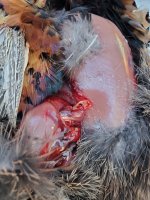Golden Hour
Well-known member
This is more of a conversation starter than me trying to say I've uncovered a mystery about pheasants, so take your grain of salt now.
Over the years, I have seen legs drop after hitting pheasants. This past Friday, I hit a pheasant about as lightly as you can hit anything with a shotgun. It's left leg dropped and it went a hundred yards and landed in the grass with Sage in hot pursuit. No more than two seconds after landing, it jumped up, took off with full force and both legs were tucked up like a plane after liftoff.
I've had this discussion with other hunters, but the more years I get under my belt and the more scenarios I encounter, I have come think that sometimes when a pheasant drops it's leg, it isn't necessarily indicative of the leg being hit. In many circumstances, it does, I won't argue otherwise. But it seems like its an autonomous reaction to getting hit, maybe the way our eyes water when getting punched in the nose. Not sure. Granted, these are the kinds of things that can probably never really be known, but I wanted to toss it out there and see if anyone else had ever put thought into this, as I know we've all seen legs drop on pheasants after hitting them.
Over the years, I have seen legs drop after hitting pheasants. This past Friday, I hit a pheasant about as lightly as you can hit anything with a shotgun. It's left leg dropped and it went a hundred yards and landed in the grass with Sage in hot pursuit. No more than two seconds after landing, it jumped up, took off with full force and both legs were tucked up like a plane after liftoff.
I've had this discussion with other hunters, but the more years I get under my belt and the more scenarios I encounter, I have come think that sometimes when a pheasant drops it's leg, it isn't necessarily indicative of the leg being hit. In many circumstances, it does, I won't argue otherwise. But it seems like its an autonomous reaction to getting hit, maybe the way our eyes water when getting punched in the nose. Not sure. Granted, these are the kinds of things that can probably never really be known, but I wanted to toss it out there and see if anyone else had ever put thought into this, as I know we've all seen legs drop on pheasants after hitting them.

